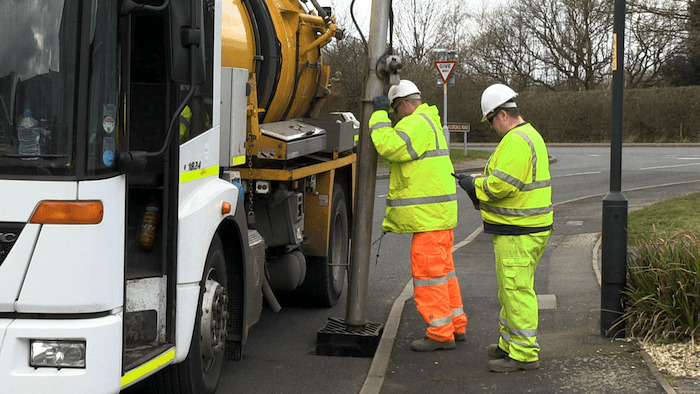The Department for Transport has introduced incentive funding for councils that adopt a risk based approach to their routine asset management. It was brought in after a National Audit Office study undertaken in 2014 showed that many highway authorities did not have an asset management strategy or plan.
SMART Drainage Software – Gully SMART
Since then gully software has been under growing scrutiny to deliver an approach that is truly risk-based. Geographic influences, historic usage and condition data can all play a part in the maintenance needs of each gully. Owing to the complex nature of the data that contributes to an asset risk score, most gully software available in the marketplace has stayed clear of attempting to develop a cleansing strategy based on risk. That was until KaarbonTech decided to take on and overcome this challenge as part of their Gully SMART solution.

In order to manage drainage networks cost-effectively, it is necessary for local highway authorities to have a robust drainage asset management strategy. The strategy must be able to support and inform decision making that addresses the need to deliver highway maintenance in a way that balances growing service demands with reducing resources.
Using a software system that allows for cleansing regimes based upon risk, removes any politics from the decision making on where to focus maintenance, enabling resources to be targeted effectively.
 Focusing of Resources
Focusing of Resources
In an age of greater visibility and transparency with regard to the general public, Local Authorities now need to focus their resources and spend the public pound wisely. A cyclical cleaning regime has been proven to not be so cost effective anymore. The Pitt Review Flood and Water Management Act 2010 clearly lays the responsibilities and requirements of drainage maintenance.
This Act establishes a hierarchy of authorities responsible for managing flood risk. The Local Highway Authority is one of those responsible for ensuring its actions are consistent with the National Flood and Coastal Erosion Risk Management Strategy in England. Changing maintenance practices can have hugely beneficial outcomes, and adding a risk based element to that can help to enhance results further.
This is exactly the type of innovation needed. The intelligence that is being gained enables us to objectively reduce the frequency of cleaning where it is not needed and prioritise problem areas.
John Roseblade, Group Manager Highways & Environment
Walsall Council Case Study
In 2012 Walsall Council drainage network was suffering from previous years of underfunding. Historically, budgets had been cut to around £200K and four vehicles reduced to one. There was no risk-based approach to cuts as no data existed beyond paper records summarising quantities.
KaarbonTech proposed managing the contract and implementing the GullySMART software to monitor productivity and condition. This would include deploying tablets, incentivising the workers, reducing downtime, and shifting the balance from reactive to proactive.
Failure to maintain road gullies in the vehicular highways systems effectively may result in.
Flooding of the carriageway surface, producing a hazard to motorists and pedestrians in wet or freezing conditions.
Flooding of land or property adjacent to the highway.
Contribute towards damage of the highway surface or sub-structure, so shortening the life-span of the carriageway construction.
The more variables that are introduced, the more authorities will become reliant on algorithms that can help them seek efficiencies and reduce wastage.
Quick Wins and Long Term Planning
Along our journey we have monitored, measured, interrogated, advised and experienced a variety of situations. Over 50 authorities representing more than 35% of the country now use our software or services for one or more asset.
On the face of things, they all look to share the same problems but delve a little deeper and you realise that no two networks are the same.
Whether separated by politics, income, asset knowledge, contractual differences or physical things like population density, flood events and condition, most of the following rules have remained the same.
Hopefully some of the points in our guide will be obvious but we would be surprised if all of them could be answered. If you want a hand hold through any of it then please let us know. Contact one of our team today for the full guide on “Quick Wins and Long Term Planning”.
Management Tips For Operational Efficiency
Operational efficiency is a well-used term in today’s market but those in the front line still represent the biggest opportunity for savings.
Blindly cutting services is a short-term gain and often unnecessary if you adopt some additional efficiency measures..
Implement technology that can support the complexity of your programme
Reporting
Most networks still report progress on a number achieved vs program with little knowledge of the detail within. “We planned to do 10,000 this month and achieved 10,000” so we’re on target right..? Probably not.
Which 10,000 did you do? Where they this month’s, last month’s or next month’s? Focus on things you didn’t do in more detail rather than just accepting it as a percentage level. You will soon realise the power of your software when you try and get clarity here.
Things that generic systems struggle to manage are
Classifying why a gully wasn’t running
Separating “cleans” from “Operational on leaving”
Managing repeat visits
Time elapsed since defects were raised
Reporting and budgeting for follow up work
Opening visibility of defects to cyclical crews
If you would like the full PDF on “Management Tips For Operational Efficiency” please contact one of our team today.
Sources
“Guidance on the management of Highway Drainage Assets” Open Government Licence Highways Efficiency Org
Pit Review / Original article published http://www.cabinetoffice.gov.uk. Now stored on National Archives
Quote from Ordnance Survey. Case Study / Walsall Council KaarbonTech Gully Smart
“Quick wins and long term planning for managing assets better”. KaarbonTech
“Management tips for operational efficiency”. KaarbonTech


-1682341256.jpg)